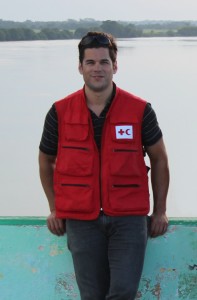
We typically think of using a cost-benefit analysis (CBA) to assess large-scale infrastructure projects, or projects with big budgets. However, people—young and old, rich and poor—apply the principles of CBA to their decisions every day, weighing the costs and benefits of a variety of activities, whether deciding which plant to crop or which materials to use to build a house. The principles underpinning the CBA process are very intuitive, though rarely applied in a systematic way in day-to-day life. In Mexico, the Red Cross is using a participatory qualitative cost-benefit analysis to guide decision-making in, and by, rural, flood-prone communities in the state of Tabasco, as part of the Global Floods Resilience Alliance.
Applying a participatory community-driven CBA process to community-based initiatives—like the small-scale risk-reduction projects the Red Cross carries out with its partners in the Alliance—can help both communities and program staff to identify and prioritize costs and benefits of potential interventions, and help them to focus on achieving sustainable and lasting change through projects that impact the broader community. Gathering data for and carrying out a qualitative CBA doesn’t necessarily need significant extra resources or technical capacity, but can have lasting impacts on DRR projects’ sustainability, relevance and basis in communities’ needs. The qualitative CBA process in Tabasco is carried out by trained Mexican Red Cross volunteers. It has led to increased social cohesion by raising awareness of choices among community members and providing a grounded basis for comparison as communities decide between flood risk-reducing activities.
From the perspective of the Red Cross and other community-based organizations and DRR actors, the participatory CBA gets further insights into how people value different aspects of their communities, and how they make choices and prioritize projects. This has implications for a project’s ability to meet a community’s self-identified needs, thereby becoming more sustainable and acceptable. The results of the CBA process can also create mid- to long-term benefits, by focusing and documenting at-risk communities’ perspectives and priorities, which can be used to complement traditional quantitative measures to make a stronger case and influence decision-makers at the regional and national levels. The community-driven CBA process creates an opportunity to develop synergy between community voices and technical knowledge, allowing each to contribute to the weighing of human, social, natural, physical and financial costs and benefits of DRR projects in at-risk communities.
Francisco Ianni is a DRR delegate with the International Federation of Red Cross and Red Crescent Societies in Mexico, as a part of the Floods Resilience Alliance, a global partnership between the IFRC; Zurich Insurance; Practical Action, a UK-based international non-governmental organization; and two research institutes – the International Institute for Applied Systems Analysis (IIASA) and the Wharton Risk Management and Decision Processes Center. In Mexico the Alliance’s resilience projects are implemented through the expertise of the Mexican Red Cross, which is currently working in 21 flood-prone communities in the state of Tabasco.